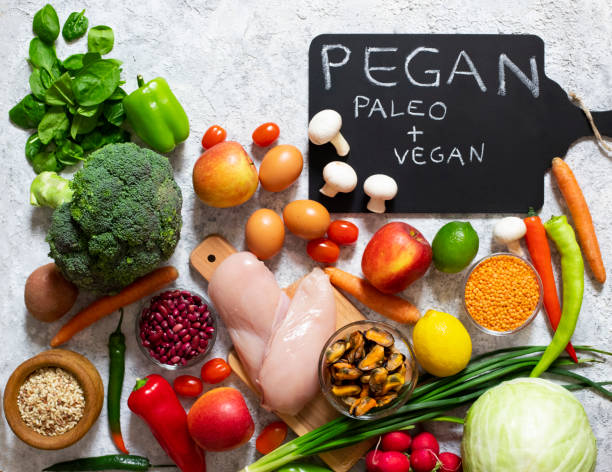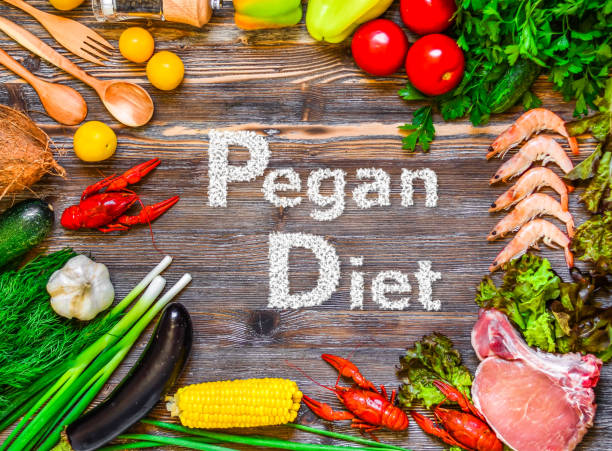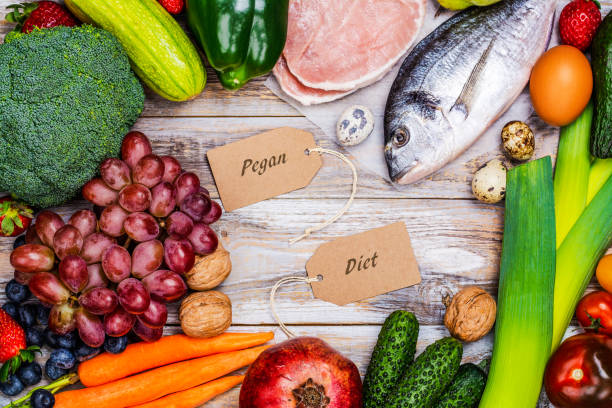What Is the Pegan Diet?
The Pegan Diet is a unique blend of the Paleo and Vegan diets, combining the best principles of both into a flexible and balanced way of eating. The Paleo diet focuses on whole, unprocessed foods like meat, fish, vegetables, nuts, and seeds, while Veganism eliminates all animal products, relying entirely on plant-based foods.
The Pegan Diet finds a middle ground by emphasizing mostly plant-based eating while allowing small amounts of high-quality animal products, such as grass-fed meat, wild-caught fish, and organic eggs. This approach promotes nutrient-rich, anti-inflammatory foods that support overall health while remaining more inclusive than strict Paleo or Vegan diets.
The Core Principles of the Pegan Diet
Dr. Mark Hyman, a well-known functional medicine doctor, created the Pegan Diet as a healthier, more balanced approach to eating. It combines the best aspects of Paleo and Vegan diets while focusing on sustainability and whole-food nutrition. Here are the key principles of the Pegan Diet:
- Focus on Whole Foods: Fresh, organic, and minimally processed foods are the foundation of this diet, promoting better nutrition and reducing exposure to harmful additives.
- Primarily Plant-Based: About 75% of your meals should consist of vegetables, fruits, nuts, and seeds, ensuring a high intake of fiber, vitamins, and antioxidants.
- Healthy Fats Are Essential: Sources like avocados, nuts, seeds, and extra virgin olive oil provide heart-healthy fats that support brain function and overall well-being.
- Limited Animal Products: The diet allows small portions of high-quality, grass-fed, pasture-raised, or sustainably sourced animal proteins in moderation.
- Low Glycemic Index Foods: To maintain stable blood sugar levels, refined carbohydrates are avoided, and fiber-rich foods such as legumes and non-starchy vegetables are encouraged.
- Dairy-Free Approach: Dairy is mostly excluded due to its potential to cause inflammation and digestive issues in some individuals.
- Gluten-Free Preference: Processed grains and gluten-containing foods are minimized to support gut health and reduce inflammation.
By following these principles, the Pegan Diet promotes a nutrient-dense, anti-inflammatory way of eating that supports long-term health.

Health Benefits of the Pegan Diet
The Pegan Diet is designed to support overall well-being by combining the best aspects of Paleo and Vegan eating. Here are some of its key health benefits:
1. Supports Heart Health
This diet is packed with heart-friendly nutrients like omega-3 fatty acids, fiber, and antioxidants, which help reduce inflammation and lower the risk of heart disease (Harvard Health). Eating more plant-based foods and healthy fats, such as nuts, seeds, and olive oil, can also help lower bad cholesterol (LDL), improve circulation, and maintain healthy blood pressure levels. Additionally, avoiding processed sugars and refined carbohydrates helps prevent blood sugar spikes, reducing strain on the heart.
By focusing on whole, nutrient-dense foods, the Pegan Diet promotes cardiovascular health and overall longevity.
2. Helps with Weight Management
The Pegan Diet supports healthy weight management by emphasizing whole, unprocessed foods and reducing refined carbohydrates. This approach helps prevent obesity and promotes steady weight loss without extreme dieting.
High-fiber foods like vegetables, fruits, nuts, and seeds help keep you full longer, reducing hunger and minimizing cravings for unhealthy snacks. Fiber also supports digestion and stabilizes blood sugar levels, which can prevent energy crashes and overeating.
Additionally, the Pegan Diet focuses on nutrient-dense foods, ensuring your body gets essential vitamins and minerals without excess calories. By prioritizing whole foods and healthy fats, this diet promotes a balanced metabolism and long-term weight control.
3. Balances Blood Sugar Levels
The Pegan Diet helps regulate blood sugar by avoiding high-glycemic foods and prioritizing fiber-rich, whole foods. This approach is especially beneficial for individuals with diabetes, insulin resistance, or those looking to maintain steady energy levels throughout the day.
By focusing on complex carbohydrates from non-starchy vegetables, legumes, and gluten-free whole grains, the diet helps prevent sudden spikes and crashes in blood sugar. These foods digest more slowly, providing a steady release of energy and reducing the risk of insulin spikes.
Additionally, the healthy fats and proteins in the Pegan Diet further support blood sugar balance by slowing digestion and keeping you full longer. By avoiding processed sugars and refined carbs, this diet helps promote better metabolic health and long-term wellness.
4. Improves Digestion
The Pegan Diet promotes better digestion by providing a high intake of fiber from vegetables, fruits, nuts, and seeds. Fiber plays a crucial role in maintaining gut health by keeping digestion regular and preventing constipation.
Eating fiber-rich foods helps nourish beneficial gut bacteria, which are essential for a healthy microbiome. A balanced gut microbiome supports digestion, boosts immunity, and may even improve mood. Additionally, the diet’s focus on whole, unprocessed foods reduces the intake of artificial additives and preservatives that can disrupt digestion.
By incorporating a variety of plant-based foods and healthy fats, the Pegan Diet creates a gut-friendly approach to eating, leading to improved digestion and overall well-being.
5. Reduces Inflammation
The Pegan Diet helps reduce inflammation by eliminating processed foods, dairy, and refined sugars—common triggers of chronic inflammation. Long-term inflammation has been linked to various health issues, including heart disease, arthritis, autoimmune disorders, and neurodegenerative diseases.
Many Pegan-friendly foods have natural anti-inflammatory properties. Berries, leafy greens, nuts, seeds, and fatty fish (if included in moderation) are rich in antioxidants and omega-3 fatty acids, which help combat oxidative stress and reduce inflammation at the cellular level. Additionally, the diet’s focus on whole, nutrient-dense foods supports the body’s natural healing processes, promoting better overall health.
By avoiding inflammatory foods and prioritizing anti-inflammatory ingredients, the Pegan Diet can help protect against chronic diseases and support long-term wellness.

Foods to Eat on the Pegan Diet
Here’s a list of Pegan-friendly foods:
Vegetables & Fruits (75% of Diet)
- Leafy greens (kale, spinach, arugula)
- Cruciferous vegetables (broccoli, cauliflower, Brussels sprouts)
- Berries (blueberries, strawberries, raspberries)
- Apples, oranges, and pears
- Sweet potatoes and squash (moderation due to natural sugars)
- Avocados (a great source of healthy fats)
Healthy Fats
- Avocados
- Nuts (almonds, walnuts, cashews)
- Seeds (chia, flax, hemp)
- Extra virgin olive oil
- Coconut oil (in moderation for cooking)
Animal Protein (25% of Diet)
- Grass-fed beef
- Free-range poultry
- Wild-caught fish (salmon, sardines, mackerel)
- Pasture-raised eggs
Other Approved Foods
- Legumes (in moderation, as some Paleo advocates avoid them)
- Gluten-free whole grains (quinoa, brown rice, amaranth)
- Fermented foods (sauerkraut, kimchi, kombucha) for gut health
Foods to Avoid on the Pegan Diet
To maximize the benefits, avoid the following:
- Dairy: Milk, cheese, and yogurt (due to potential inflammation)
- Gluten: Wheat, barley, and rye (may contribute to digestive issues)
- Processed Foods: Packaged snacks, sugary cereals, and fast food
- Refined Sugar: Soda, candy, and baked goods (causes blood sugar spikes)
- Artificial Additives: Preservatives, food colorings, and artificial sweeteners
How to Start the Pegan Diet
Starting the Pegan Diet is simple when you take small, manageable steps. Here’s how to transition smoothly:
- Gradually Reduce Processed Foods – Cut back on refined carbs, added sugars, and artificial ingredients. Replace them with whole, unprocessed foods like fresh vegetables, fruits, and lean proteins.
- Increase Plant-Based Foods – Aim to fill about 75% of your plate with vegetables, fruits, nuts, and seeds. This ensures you get plenty of fiber, vitamins, and antioxidants.
- Choose High-Quality Protein – If you include animal products, choose grass-fed meats, pasture-raised eggs, and wild-caught fish to ensure the highest nutritional value.
- Focus on Healthy Fats – Incorporate heart-healthy fats like avocados, nuts, seeds, and olive oil to support brain function and reduce inflammation.
- Experiment with New Recipes – Explore Pegan-friendly meals to keep your diet exciting. Try grain-free bowls, hearty salads, or vegetable-based stir-fries.
- Read Labels Carefully – Many packaged foods contain hidden sugars, gluten, and artificial additives. Always check ingredient lists to ensure you’re making Pegan-friendly choices.
- Meal Prep for Success – Plan and prepare meals ahead of time to make it easier to stick to the diet, especially on busy days.
By following these steps, you can ease into the Pegan lifestyle and enjoy its many health benefits without feeling overwhelmed.

Sample Pegan Meal Plan
Breakfast:
Avocado toast on gluten-free bread with a side of fresh berries and a green smoothie with spinach, almond milk, and chia seeds.
Lunch:
Grilled salmon with quinoa and a spinach salad with olive oil dressing, topped with walnuts and cranberries.
Dinner:
Stir-fried vegetables with tofu and cashew sauce over cauliflower rice. Add some fermented kimchi on the side for gut health.
Snacks:
- Handful of almonds and walnuts
- Carrot sticks with hummus
- Chia pudding with coconut milk and cinnamon
- Sliced apples with almond butter
Is the Pegan Diet Right for You?
The Pegan Diet is an excellent choice for those looking for a balanced, sustainable approach to eating. It provides flexibility while promoting health and well-being. However, if you have specific dietary needs, consult a healthcare professional before making changes.
Who Might Benefit Most from the Pegan Diet?
- People with inflammatory conditions, such as arthritis
- Those looking for a heart-healthy diet
- Individuals with insulin resistance or type 2 diabetes
- Anyone seeking a plant-rich but flexible diet
Potential Challenges of the Pegan Diet
- May require more meal planning and preparation
- Can be expensive due to organic and high-quality ingredients
- Some people may struggle with reducing dairy and gluten
Final Thoughts
The Pegan Diet combines the best of Paleo and Vegan eating to create a nutrient-rich, anti-inflammatory way of life. It prioritizes whole foods, minimizes processed ingredients, and offers flexibility for personal preferences.
Are you ready to give the Pegan Diet a try? Let us know in the comments below what you think or share your favorite Pegan recipes!



